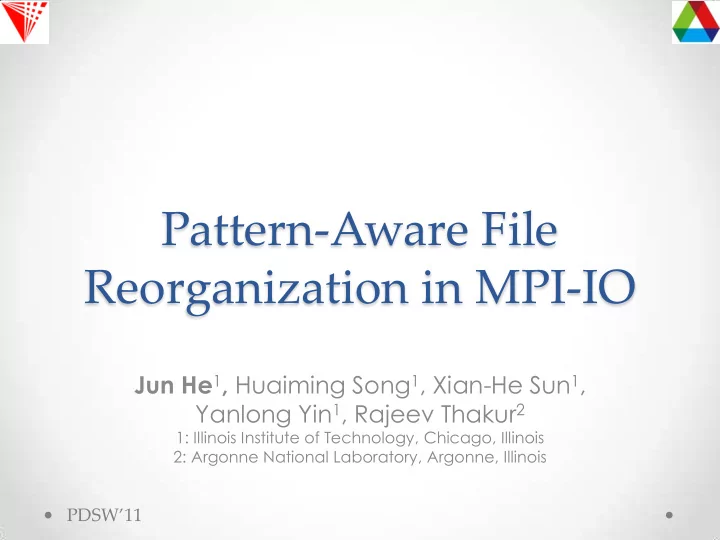

Pattern-Aware File Reorganization in MPI-IO Jun He 1 , Huaiming Song 1 , Xian-He Sun 1 , Yanlong Yin 1 , Rajeev Thakur 2 1: Illinois Institute of Technology, Chicago, Illinois 2: Argonne National Laboratory, Argonne, Illinois PDSW’11
Outline Motivation • Examples o Basic idea o Design • System Overview o Trace collecting o Pattern classification o I/O Trace analyzer o Remapping table o MPI-IO remapping layer o Evaluation • Remapping overhead o Pattern variation o Benchmarks o Conclusion & Future Work • PDSW’11
Motivation PDSW’11
Parallel File Systems A typical parallel file system • Important Factors Network overhead IOPS o Number of requests Locality o Contiguousness of accesses … PDSW’11
Mismatch • Logical data o Developer’s understanding, for programmability and runtime performance o -> Logical organization -> Access pattern • Physical data o Where the data blocks are stored o -> Physical data organization Good logical organization != Good physical organization for better I/O performance PDSW’11
A Tiny Example for Irregular Data 0 1 2 3 4 5 6 7 8 9 Programmer’s view Also file system’s view 3 5 8 7 4 2 1 0 9 6 Potential benefit: Better spatial locality Easier for some optimization to take effect Less disk head movements … PDSW’11
An Example for Regular 2-d Array Default Organization A 2-D array PDSW’11
Read a Subarray A 2-D array PDSW’11
After Re-organizing PDSW’11
A Messier One • Irregular data • Very complex data model • Computation which involves multiple data fields PDSW’11
Pattern-Aware Reorganization Be aware of repeating non-contiguous access patterns • n-d strided and irregular o Try to reorganize the data so that data is contiguous. • Less network overhead o Less IO operations o Better locality o Beneficial for other optimizations, e.g. data sieving… o Motivating Scenarios • Application start-up o Data analysis, visualization o … o Where it does not apply • Patterns do not repeat from run to run. o PDSW’11
Design PDSW’11
System Overview Application Remapping MPI-IO Table Remapping Layer I/O Trace I/O Traces Analyzer I/O Client PDSW’11
Trace Collecting • Wrap the original function call Add recording function o Call original function inside o • Process ID, MPI rank, file path, type of operation, offset, length, data type, time stamp, and file view Application Remapping MPI-IO Table Remapping Layer I/O Trace I/O Traces Analyzer I/O Client PDSW’11
Pattern Classification Request Size Spatial Pattern Fixed Small Contiguous Variable Medium Non-contiguous Large Fixed strided Repetition 2d-strided Single occurrence Negative strided Repeating Random strided I/O Operation Temporal Intervals kd-strided Read only Fixed Combination of contiguous and Write only Random non-contiguous patterns Read/write PDSW’11
I/O Trace Analyzer • Pattern matching Sort Traces by time o Separate by process o Find out patterns o • I/O Signature {I/O operation, initial position, dimension, ([{offset Pattern}, {request size pattern}, {pattern of number of repetitions}, {temporal pattern}], [...]), # of repetitions} Application Remapping MPI-IO Table Remapping Layer I/O Trace I/O Traces Analyzer I/O Client PDSW’11
I/O-signature-based Remapping Table Old New File, {MPI_READ, offset0, 1, Offset0’ ([(hole size, 1), LEN, 1]), 4} Example, 1-d strided LEN LEN LEN LEN Offset 0 Offset 1 Offset 2 Offset 3 Offset 0' Offset 1' Offset 2' Offset 3' Application Remapping MPI-IO Table Remapping Layer I/O Trace I/O Traces Analyzer I/O Client PDSW’11
MPI-IO Remapping Layer • Convert old offsets to new ones Example: • Read m bytes data from offset f . • Whether this access falls in a 1-d strided pattern ? starting offset off o Application read size rsz o Remapping MPI-IO hole size hsz Table o Remapping Layer number of accesses of this pattern n I/O Trace o I/O Traces Analyzer I/O Client • (f-off)/(rsz+hsz) <n (1) • (f-off)%(rsz+hsz) = 0 (2) • m = rsz (3) newoff = off+rsz*(f-off)/(rsz+hsz) PDSW’11
Evaluation PDSW’11
Experiment Environment • Dual 2.3GHz Opteron quad-core processors • 8G memory • 250GB 7200RPM SATA hard drive • 100GB PCI-E OCZ Revodrive X2 SSD (read: up to 740 MB/s, write: up to 690 MB/s). Ethernet/Infiniband • Ubuntu 9.04 (Linux kernel 2.6.28-11-server) • PVFS2 2.8.1: stripe size 64 KB • MPICH2 1.3.1 • PDSW’11
Remapping Overhead 1-D Strided Remapping Table Performance (1,000,000 accesses) Table Type Size (bytes) Building time Time of (sec) 1,000,000 lookups (sec) 1-to-1 64,000,000 0.780287 0.489902 I/O Signature 28 0.000000269 0.024771 Who use 1-to-1: PLFS uses 1-to-1 mapping table in index file. Most OS file systems also use similar table to store free blocks in disk. PDSW’11
Request Size Variation • X: different of request size. For example, 5% means the actual request size is 5% less than the one assumed. PDSW’11
Variation of Starting Offset • X: difference of starting offsets. 5% means that the starting offset moved to the 5%th of the whole access. PDSW’11
R/W Performance – on IOR 4 I/O clients, 4 I/O servers. 64 processes with HDD and Infiniband • PDSW’11
Performance on MPI- TILE-IO 4 I/O clients, 4 I/O servers. 64 processes with HDD and Infiniband. • Elements in a tile: 1024x1024. PDSW’11
Performance on MPI- TILE-IO with SSD 4 I/O clients, 4 I/O servers. 64 processes with SSD and Infiniband. • Elements in a tile: 1024x1024. PDSW’11
Conclusion & Future Work Conclusion Different file organizations lead to very different • performance. Bridging logical data and physical data • Access pattern -> better organization -> better performance Future Work Multiple replicas with different organizations. • More complicated access patterns, patterns with hints • File reorganization for emerging storage medias, such as • SSD PDSW’11
Acknowledgement • Hui Jin and Spenser Gilliland (Illinois Institute of Technology) • Ce Yu (Tianjin University, China) • Samuel Lang (Argonne National Laboratory) • NSF grant CCF-0621435, CCF-0937877 • Office of Advanced Scientific Computing Research, Office of Science, U.S. DOE, under Contract DEAC02-06CH11357. Thanks! PDSW’11
Recommend
More recommend